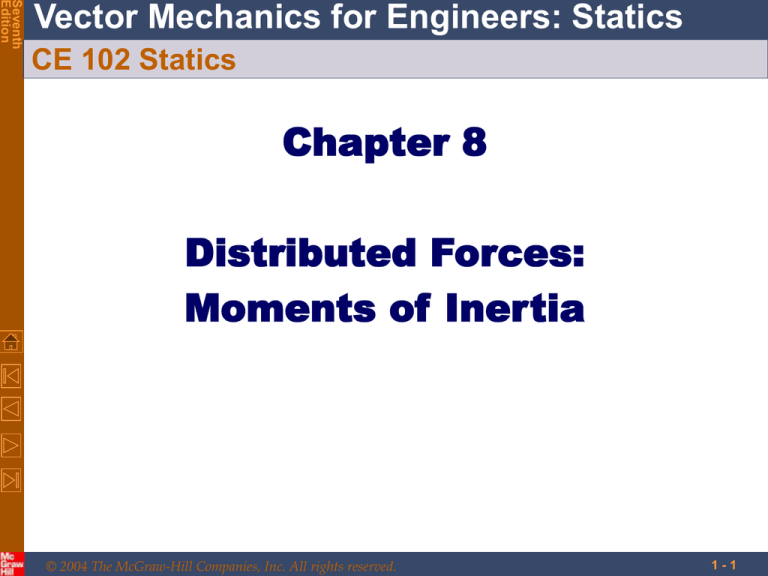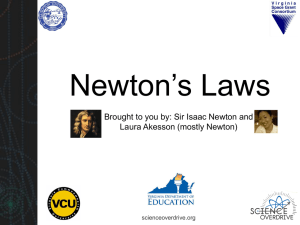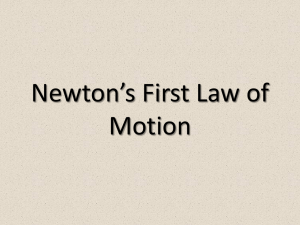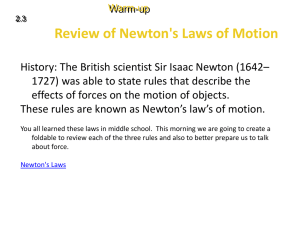
Seventh
Edition
Vector Mechanics for Engineers: Statics
CE 102 Statics
Chapter 8
Distributed Forces:
Moments of Inertia
© 2004 The McGraw-Hill Companies, Inc. All rights reserved.
1-1
Seventh
Edition
Vector Mechanics for Engineers: Statics
Contents
Introduction
Moments of Inertia of an Area
Moment of Inertia of an Area by
Integration
Polar Moment of Inertia
Radius of Gyration of an Area
Sample Problem 8.1
Sample Problem 8.2
Parallel Axis Theorem
Moments of Inertia of Composite
Areas
Sample Problem 8.3
Sample Problem 8.4
Product of Inertia
Principal Axes and Principal Moments
of Inertia
Sample Problem 8.5
Sample Problem 8.6
Mohr’s Circle for Moments and Products
of Inertia
Sample Problem 8.7
Moment of Inertia of a Mass
Parallel Axis Theorem
Moment of Inertia of Thin Plates
Moment of Inertia of a 3D Body by
Integration
Moment of Inertia of Common Geometric
Shapes
Sample Problem 8.89
Moment of Inertia With Respect to an
Arbitrary Axis
Ellipsoid of Inertia. Principle Axes of
Axes of Inertia of a Mass
© 2004 The McGraw-Hill Companies, Inc. All rights reserved.
1-2
Seventh
Edition
Vector Mechanics for Engineers: Statics
Introduction
• Previously considered distributed forces which were proportional to the
area or volume over which they act.
- The resultant was obtained by summing or integrating over the
areas or volumes.
- The moment of the resultant about any axis was determined by
computing the first moments of the areas or volumes about that
axis.
• Will now consider forces which are proportional to the area or volume
over which they act but also vary linearly with distance from a given axis.
- It will be shown that the magnitude of the resultant depends on the
first moment of the force distribution with respect to the axis.
- The point of application of the resultant depends on the second
moment of the distribution with respect to the axis.
• Current chapter will present methods for computing the moments and
products of inertia for areas and masses.
© 2004 The McGraw-Hill Companies, Inc. All rights reserved.
1-3
Seventh
Edition
Vector Mechanics for Engineers: Statics
Moment of Inertia of an Area
• Consider distributed forces F whose magnitudes are
proportional to the elemental areas A on which they
act and also vary linearly with the distance of A
from a given axis.
• Example: Consider a beam subjected to pure bending.
Internal forces vary linearly with distance from the
neutral axis which passes through the section centroid.
F kyA
R k y dA 0 y dA Qx first moment
2
M k y 2 dA
y dA second moment
• Example: Consider the net hydrostatic force on a
submerged circular gate.
F pA yA
R y dA
M x y 2 dA
© 2004 The McGraw-Hill Companies, Inc. All rights reserved.
1-4
Seventh
Edition
Vector Mechanics for Engineers: Statics
Moment of Inertia of an Area by Integration
• Second moments or moments of inertia of
an area with respect to the x and y axes,
I x y 2 dA
I y x 2 dA
• Evaluation of the integrals is simplified by
choosing dA to be a thin strip parallel to
one of the coordinate axes.
• For a rectangular area,
h
I x y dA y 2bdy 13 bh3
2
0
• The formula for rectangular areas may also
be applied to strips parallel to the axes,
dI x 13 y 3dx
© 2004 The McGraw-Hill Companies, Inc. All rights reserved.
dI y x 2 dA x 2 y dx
1-5
Seventh
Edition
Vector Mechanics for Engineers: Statics
Polar Moment of Inertia
• The polar moment of inertia is an important
parameter in problems involving torsion of
cylindrical shafts and rotations of slabs.
J 0 r 2 dA
• The polar moment of inertia is related to the
rectangular moments of inertia,
J 0 r 2 dA x 2 y 2 dA x 2 dA y 2 dA
I y Ix
© 2004 The McGraw-Hill Companies, Inc. All rights reserved.
1-6
Seventh
Edition
Vector Mechanics for Engineers: Statics
Radius of Gyration of an Area
• Consider area A with moment of inertia
Ix. Imagine that the area is
concentrated in a thin strip parallel to
the x axis with equivalent Ix.
I
I x k x2 A
kx x
A
kx = radius of gyration with respect
to the x axis
• Similarly,
Iy
k y2 A
ky
J O kO2 A kO
Iy
A
JO
A
kO2 k x2 k y2
© 2004 The McGraw-Hill Companies, Inc. All rights reserved.
1-7
Seventh
Edition
Vector Mechanics for Engineers: Statics
Sample Problem 8.1
SOLUTION:
• A differential strip parallel to the x axis is chosen for
dA.
dI x y 2dA
dA l dy
• For similar triangles,
Determine the moment of
inertia of a triangle with respect
to its base.
l h y
b
h
l b
h y
h
dA b
h y
dy
h
• Integrating dIx from y = 0 to y = h,
h y
bh 2
I x y dA y b
dy hy y 3 dy
h
h0
0
2
h
2
h
b y3 y 4
h
h 3
4
0
© 2004 The McGraw-Hill Companies, Inc. All rights reserved.
bh3
I x
12
1-8
Seventh
Edition
Vector Mechanics for Engineers: Statics
Sample Problem 8.2
SOLUTION:
• An annular differential area element is chosen,
dA 2 u du
dJ O u 2dA
r
r
J O dJ O u 2 u du 2 u 3du
2
0
0
JO
a) Determine the centroidal polar
moment of inertia of a circular
area by direct integration.
2
r4
• From symmetry, Ix = Iy,
JO I x I y 2I x
b) Using the result of part a,
determine the moment of inertia
of a circular area with respect to a
diameter.
© 2004 The McGraw-Hill Companies, Inc. All rights reserved.
2
r 4 2I x
I diameter I x
4
r4
1-9
Seventh
Edition
Vector Mechanics for Engineers: Statics
Parallel Axis Theorem
• Consider moment of inertia I of an area A
with respect to the axis AA’
I y 2 dA
• The axis BB’ passes through the area centroid
and is called a centroidal axis.
I y 2 dA y d 2 dA
y 2 dA 2d y dA d 2 dA
I I Ad 2
© 2004 The McGraw-Hill Companies, Inc. All rights reserved.
parallel axis theorem
1 - 10
Seventh
Edition
Vector Mechanics for Engineers: Statics
Parallel Axis Theorem
• Moment of inertia IT of a circular area with
respect to a tangent to the circle,
I T I Ad 2 14 r 4 r 2 r 2
54 r 4
• Moment of inertia of a triangle with respect to a
centroidal axis,
I AA I BB Ad 2
I BB I AA Ad
2
1 bh 3
12
2
1
1
2 bh 3 h
1 bh 3
36
© 2004 The McGraw-Hill Companies, Inc. All rights reserved.
1 - 11
Seventh
Edition
Vector Mechanics for Engineers: Statics
Moments of Inertia of Composite Areas
• The moment of inertia of a composite area A about a given axis is
obtained by adding the moments of inertia of the component areas
A1, A2, A3, ... , with respect to the same axis.
© 2004 The McGraw-Hill Companies, Inc. All rights reserved.
1 - 12
Seventh
Edition
Vector Mechanics for Engineers: Statics
Moments of Inertia of Composite Areas
© 2004 The McGraw-Hill Companies, Inc. All rights reserved.
1 - 13
Seventh
Edition
Vector Mechanics for Engineers: Statics
Sample Problem 8.3
SOLUTION:
• Determine location of the centroid of
composite section with respect to a
coordinate system with origin at the
centroid of the beam section.
The strength of a W14x38 rolled steel
beam is increased by attaching a plate
to its upper flange.
Determine the moment of inertia and
radius of gyration with respect to an
axis which is parallel to the plate and
passes through the centroid of the
section.
• Apply the parallel axis theorem to
determine moments of inertia of beam
section and plate with respect to
composite section centroidal axis.
• Calculate the radius of gyration from the
moment of inertia of the composite
section.
© 2004 The McGraw-Hill Companies, Inc. All rights reserved.
1 - 14
Seventh
Edition
Vector Mechanics for Engineers: Statics
Sample Problem 8.3
SOLUTION:
• Determine location of the centroid of composite section
with respect to a coordinate system with origin at the
centroid of the beam section.
Section
A, in 2
Plate
6.75
Beam Section 11.20
A 17.95
Y A yA
© 2004 The McGraw-Hill Companies, Inc. All rights reserved.
y , in. yA, in 3
7.425 50.12
0
0
yA 50.12
yA 50.12 in 3
Y
2.792 in.
2
A
17.95 in
1 - 15
Seventh
Edition
Vector Mechanics for Engineers: Statics
Sample Problem 8.3
• Apply the parallel axis theorem to determine moments of
inertia of beam section and plate with respect to composite
section centroidal axis.
I x, beam section I x AY 2 385 11.202.7922
472.3 in 4
3
1 9 3 6.757.425 2.7922
I x, plate I x Ad 2 12
4
145.2 in 4
I x I x,beam section I x,plate 472.3 145.2
I x 618 in 4
• Calculate the radius of gyration from the moment of inertia
of the composite section.
k x
I x 617.5 in 4
A 17.95 in 2
© 2004 The McGraw-Hill Companies, Inc. All rights reserved.
k x 5.87 in.
1 - 16
Seventh
Edition
Vector Mechanics for Engineers: Statics
Sample Problem 8.4
SOLUTION:
• Compute the moments of inertia of the
bounding rectangle and half-circle with
respect to the x axis.
• The moment of inertia of the shaded area is
obtained by subtracting the moment of
inertia of the half-circle from the moment
of inertia of the rectangle.
Determine the moment of inertia
of the shaded area with respect to
the x axis.
© 2004 The McGraw-Hill Companies, Inc. All rights reserved.
1 - 17
Seventh
Edition
Vector Mechanics for Engineers: Statics
Sample Problem 8.4
SOLUTION:
• Compute the moments of inertia of the bounding
rectangle and half-circle with respect to the x axis.
Rectangle:
I x 13 bh3 13 240120 138.2 106 mm 4
Half-circle:
moment of inertia with respect to AA’,
I AA 18 r 4 18 904 25.76 106 mm 4
moment of inertia with respect to x’,
4r 4 90
a
38.2 mm
3
3
b 120 - a 81.8 mm
A 12 r 12 90
2
2
12.72 103 mm 2
I x I AA Aa 2 25.76 106 12.72 103
7.20 106 mm 4
moment of inertia with respect to x,
I x I x Ab2 7.20 106 12.72 103 81.82
92.3 106 mm 4
© 2004 The McGraw-Hill Companies, Inc. All rights reserved.
1 - 18
Seventh
Edition
Vector Mechanics for Engineers: Statics
Sample Problem 8.4
• The moment of inertia of the shaded area is obtained by
subtracting the moment of inertia of the half-circle from
the moment of inertia of the rectangle.
Ix
138.2 106 mm 4
92.3 106 mm 4
I x 45.9 106 mm 4
© 2004 The McGraw-Hill Companies, Inc. All rights reserved.
1 - 19
Seventh
Edition
Vector Mechanics for Engineers: Statics
Product of Inertia
• Product of Inertia:
I xy xy dA
• When the x axis, the y axis, or both are an
axis of symmetry, the product of inertia is
zero.
• Parallel axis theorem for products of inertia:
I xy I xy xyA
© 2004 The McGraw-Hill Companies, Inc. All rights reserved.
1 - 20
Seventh
Edition
Vector Mechanics for Engineers: Statics
Principal Axes and Principal Moments of Inertia
• The change of axes yields
Ix I y Ix I y
I x
cos 2 I xy sin 2
2
2
Ix Iy Ix Iy
I y
cos 2 I xy sin 2
2
2
Ix Iy
I xy
sin 2 I xy cos 2
2
Given I x y 2 dA I y x 2 dA
I xy xy dA
we wish to determine moments
and product of inertia with
respect to new axes x’ and y’.
Note: x x cos y sin
y y cos x sin
• The equations for Ix’ and Ix’y’ are the
parametric equations for a circle,
I x I ave 2 I x2y R 2
I ave
Ix I y
2
Ix I y 2
I xy
R
2
• The equations for Iy’ and Ix’y’ lead to the
same circle.
© 2004 The McGraw-Hill Companies, Inc. All rights reserved.
1 - 21
Seventh
Edition
Vector Mechanics for Engineers: Statics
Principal Axes and Principal Moments of Inertia
• At the points A and B, Ix’y’ = 0 and Ix’ is
a maximum and minimum, respectively.
I max,min I ave R
tan 2 m
2 I xy
Ix I y
• The equation for Qm defines two
angles, 90o apart which correspond to
the principal axes of the area about O.
I x I ave 2 I x2y R 2
I ave
Ix I y
2
Ix I y 2
I xy
R
2
• Imax and Imin are the principal moments
of inertia of the area about O.
© 2004 The McGraw-Hill Companies, Inc. All rights reserved.
1 - 22
Seventh
Edition
Vector Mechanics for Engineers: Statics
Sample Problem 8.5
SOLUTION:
• Determine the product of inertia using
direct integration with the parallel axis
theorem on vertical differential area strips
• Apply the parallel axis theorem to
evaluate the product of inertia with respect
to the centroidal axes.
Determine the product of inertia of
the right triangle (a) with respect
to the x and y axes and
(b) with respect to centroidal axes
parallel to the x and y axes.
© 2004 The McGraw-Hill Companies, Inc. All rights reserved.
1 - 23
Seventh
Edition
Vector Mechanics for Engineers: Statics
Sample Problem 8.5
SOLUTION:
• Determine the product of inertia using direct integration
with the parallel axis theorem on vertical differential
area strips
x
x
y h1 dA y dx h1 dx
b
b
x
xel x
yel 12 y 12 h1
b
Integrating dIx from x = 0 to x = b,
b
I xy dI xy xel yel dA x
0
b
12
2
2
x
h 1 dx
b
2
b
x 2 x3 x 4
x
2 x x
h
dx h 2
2 b 2b 2
0
4 3b 8b 0
2
3
I xy
© 2004 The McGraw-Hill Companies, Inc. All rights reserved.
1 b2h2
24
1 - 24
Seventh
Edition
Vector Mechanics for Engineers: Statics
Sample Problem 8.5
• Apply the parallel axis theorem to evaluate the
product of inertia with respect to the centroidal axes.
x 13 b
y 13 h
With the results from part a,
I xy I xy xyA
13 h12 bh
1 b2h2 1 b
I xy 24
3
1 b2h2
I xy 72
© 2004 The McGraw-Hill Companies, Inc. All rights reserved.
1 - 25
Seventh
Edition
Vector Mechanics for Engineers: Statics
Sample Problem 8.6
SOLUTION:
• Compute the product of inertia with
respect to the xy axes by dividing the
section into three rectangles and applying
the parallel axis theorem to each.
• Determine the orientation of the
principal axes (Eq. 9.25) and the
principal moments of inertia (Eq. 9. 27).
For the section shown, the moments of
inertia with respect to the x and y axes
are Ix = 10.38 in4 and Iy = 6.97 in4.
Determine (a) the orientation of the
principal axes of the section about O,
and (b) the values of the principal
moments of inertia about O.
© 2004 The McGraw-Hill Companies, Inc. All rights reserved.
1 - 26
Seventh
Edition
Vector Mechanics for Engineers: Statics
Sample Problem 8.6
SOLUTION:
• Compute the product of inertia with respect to the xy axes
by dividing the section into three rectangles.
Apply the parallel axis theorem to each rectangle,
I xy I xy xyA
Note that the product of inertia with respect to centroidal
axes parallel to the xy axes is zero for each rectangle.
Rectangle
I
II
III
Area, in 2
x , in.
y , in.
1.5 1.25 1.75
1.5
0
x yA, in 4
3.28
0
0
1.5 1.25 1.75
3.28
x yA 6.56
I xy x yA 6.56 in 4
© 2004 The McGraw-Hill Companies, Inc. All rights reserved.
1 - 27
Seventh
Edition
Vector Mechanics for Engineers: Statics
Sample Problem 8.6
• Determine the orientation of the principal axes (Eq. 9.25)
and the principal moments of inertia (Eq. 9. 27).
tan 2 m
2 I xy
Ix I y
2 6.56
3.85
10.38 6.97
2 m 75.4 and 255.4
m 37.7 and m 127.7
I x 10.38 in
4
I y 6.97 in 4
I xy 6.56 in
I max, min
Ix I y
2
2
Ix I y
2
I xy
2
2
4
10.38 6.97
10.38 6.97
2
6.56
2
2
I a I max 15.45 in 4
Ib I min 1.897 in 4
© 2004 The McGraw-Hill Companies, Inc. All rights reserved.
1 - 28
Seventh
Edition
Vector Mechanics for Engineers: Statics
Mohr’s Circle for Moments and Products of Inertia
• The moments and product of inertia for an area
are plotted as shown and used to construct Mohr’s
circle,
I ave
Ix I y
2
Ix I y 2
I xy
R
2
• Mohr’s circle may be used to graphically or
analytically determine the moments and product of
inertia for any other rectangular axes including the
principal axes and principal moments and products
of inertia.
© 2004 The McGraw-Hill Companies, Inc. All rights reserved.
1 - 29
Seventh
Edition
Vector Mechanics for Engineers: Statics
Sample Problem 8.7
SOLUTION:
• Plot the points (Ix , Ixy) and (Iy ,-Ixy).
Construct Mohr’s circle based on the
circle diameter between the points.
• Based on the circle, determine the
orientation of the principal axes and the
principal moments of inertia.
The moments and product of inertia
with respect to the x and y axes are Ix =
7.24x106 mm4, Iy = 2.61x106 mm4, and
Ixy = -2.54x106 mm4.
• Based on the circle, evaluate the
moments and product of inertia with
respect to the x’y’ axes.
Using Mohr’s circle, determine (a) the
principal axes about O, (b) the values of
the principal moments about O, and (c)
the values of the moments and product
of inertia about the x’ and y’ axes
© 2004 The McGraw-Hill Companies, Inc. All rights reserved.
1 - 30
Seventh
Edition
Vector Mechanics for Engineers: Statics
Sample Problem 8.7
SOLUTION:
• Plot the points (Ix , Ixy) and (Iy ,-Ixy). Construct Mohr’s
circle based on the circle diameter between the points.
OC I ave 12 I x I y 4.925 106 mm 4
CD 12 I x I y 2.315 106 mm 4
R
I x 7.24 106 mm 4
I y 2.61 106 mm 4
I xy 2.54 106 mm 4
CD2 DX 2 3.437 106 mm 4
• Based on the circle, determine the orientation of the
principal axes and the principal moments of inertia.
tan 2 m
DX
1.097 2 m 47.6
CD
m 23.8
I max OA I ave R
I max 8.36 106 mm 4
I min OB I ave R
I min 1.49 106 mm 4
© 2004 The McGraw-Hill Companies, Inc. All rights reserved.
1 - 31
Seventh
Edition
Vector Mechanics for Engineers: Statics
Sample Problem 8.7
• Based on the circle, evaluate the moments and product
of inertia with respect to the x’y’ axes.
The points X’ and Y’ corresponding to the x’ and y’ axes
are obtained by rotating CX and CY counterclockwise
through an angle Q 2(60o) = 120o. The angle that CX’
forms with the x’ axes is f = 120o - 47.6o = 72.4o.
I x' OF OC CX cos I ave R cos 72.4o
I x 5.96 106 mm 4
I y ' OG OC CY cos I ave R cos 72.4o
I y 3.89 106 mm 4
I xy ' FX CY sin R sin 72.4o
OC I ave 4.925 106 mm 4
I xy 3.28 106 mm 4
R 3.437 106 mm 4
© 2004 The McGraw-Hill Companies, Inc. All rights reserved.
1 - 32
Seventh
Edition
Vector Mechanics for Engineers: Statics
Moment of Inertia of a Mass
• Angular acceleration about the axis AA’ of the
small mass m due to the application of a
couple is proportional to r2m.
r2m = moment of inertia of the
mass m with respect to the
axis AA’
• For a body of mass m the resistance to rotation
about the axis AA’ is
I r12 m r22 m r32 m
r 2 dm mass moment of inertia
• The radius of gyration for a concentrated mass
with equivalent mass moment of inertia is
I k 2m
© 2004 The McGraw-Hill Companies, Inc. All rights reserved.
k
I
m
1 - 33
Seventh
Edition
Vector Mechanics for Engineers: Statics
Moment of Inertia of a Mass
• Moment of inertia with respect to the y coordinate
axis is
I y r 2 dm z 2 x 2 dm
• Similarly, for the moment of inertia with respect to
the x and z axes,
I z x 2 y 2 dm
I x y 2 z 2 dm
• In SI units,
I r 2 dm kg m 2
In U.S. customary units,
lb s 2 2
2
I slug ft
ft lb ft s 2
ft
© 2004 The McGraw-Hill Companies, Inc. All rights reserved.
1 - 34
Seventh
Edition
Vector Mechanics for Engineers: Statics
Parallel Axis Theorem
• For the rectangular axes with origin at O and parallel
centroidal axes,
y 2 z 2 dm 2 y y dm 2 z z dm y 2 z 2 dm
I x I x my 2 z 2
I y I y mz 2 x 2
I z I z mx 2 y 2
I x y 2 z 2 dm y y 2 z z 2 dm
• Generalizing for any axis AA’ and a parallel centroidal
axis,
I I md 2
© 2004 The McGraw-Hill Companies, Inc. All rights reserved.
1 - 35
Seventh
Edition
Vector Mechanics for Engineers: Statics
Moments of Inertia of Thin Plates
• For a thin plate of uniform thickness t and homogeneous
material of density r, the mass moment of inertia with
respect to axis AA’ contained in the plate is
I AA r 2 dm rt r 2 dA
r t I AA,area
• Similarly, for perpendicular axis BB’ which is also
contained in the plate,
I BB rt I BB,area
• For the axis CC’ which is perpendicular to the plate,
I CC r t J C ,area r t I AA,area I BB,area
I AA I BB
© 2004 The McGraw-Hill Companies, Inc. All rights reserved.
1 - 36
Seventh
Edition
Vector Mechanics for Engineers: Statics
Moments of Inertia of Thin Plates
• For the principal centroidal axes on a rectangular plate,
121 a3b 121 ma2
1 ab3 1 mb 2
I BB rt I BB,area rt 12
12
1 ma 2 b 2
I CC I AA,mass I BB,mass 12
I AA rt I AA,area rt
• For centroidal axes on a circular plate,
I AA I BB rt I AA,area rt 14 r 4 14 mr 2
I CC I AA I BB 12 mr 2
© 2004 The McGraw-Hill Companies, Inc. All rights reserved.
1 - 37
Seventh
Edition
Vector Mechanics for Engineers: Statics
Moments of Inertia of a 3D Body by Integration
• Moment of inertia of a homogeneous body
is obtained from double or triple
integrations of the form
I r r 2 dV
• For bodies with two planes of symmetry,
the moment of inertia may be obtained
from a single integration by choosing thin
slabs perpendicular to the planes of
symmetry for dm.
• The moment of inertia with respect to a
particular axis for a composite body may
be obtained by adding the moments of
inertia with respect to the same axis of the
components.
© 2004 The McGraw-Hill Companies, Inc. All rights reserved.
1 - 38
Seventh
Edition
Vector Mechanics for Engineers: Statics
Moments of Inertia of Common Geometric Shapes
© 2004 The McGraw-Hill Companies, Inc. All rights reserved.
1 - 39
Seventh
Edition
Vector Mechanics for Engineers: Statics
Sample Problem 8.8
SOLUTION:
• With the forging divided into a prism and
two cylinders, compute the mass and
moments of inertia of each component
with respect to the xyz axes using the
parallel axis theorem.
• Add the moments of inertia from the
components to determine the total moments
of inertia for the forging.
Determine the moments of inertia
of the steel forging with respect to
the xyz coordinate axes, knowing
that the specific weight of steel is
490 lb/ft3.
© 2004 The McGraw-Hill Companies, Inc. All rights reserved.
1 - 40
Seventh
Edition
Vector Mechanics for Engineers: Statics
Sample Problem 8.8
SOLUTION:
• Compute the moments of inertia
of each component with respect
to the xyz axes.
cylinders a 1in ., L 3in ., x 2.5in ., y 2in. :
I x 12 ma2 my 2
2 0.0829122 2
1
12 0.0829 12
2.59 103 lb ft s 2
1 m 3a 2 L2 mx 2
I y 12
2 123 2 0.0829212.5 2
1 0.08293 1
12
12
4.17 103 lb ft s 2
each cylinder :
m
V
g
490 lb/ft 1 3in
1728in 3 ft 3 32.2 ft s2
3
m 0.0829 lb s 2 ft
2
3
1 m 3a 2 L2 m x 2 y 2
I y 12
2 123 2 0.0829212.5 2 122 2
1 0.08293 1
12
12
6.48 103 lb ft s 2
© 2004 The McGraw-Hill Companies, Inc. All rights reserved.
1 - 41
Seventh
Edition
Vector Mechanics for Engineers: Statics
Sample Problem 8.8
prism (a = 2 in., b = 6 in., c = 2 in.):
122 2
1 m b 2 c 2 1 0.211 6 2
I x I z 12
12
12
4.88 103 lb ft s 2
2 122 2
1 m c 2 a 2 1 0.211 2
I y 12
12
12
0.977 103 lb ft s 2
• Add the moments of inertia from the
components to determine the total moments of
inertia.
I x 4.88 103 2 2.59 103
prism :
m
V
g
490 lb/ft 3 2 2 6in 3
1728in 3 ft 3 32.2 ft s2
m 0.211 lb s 2 ft
I x 10.06 103 lb ft s2
I y 0.977 103 2 4.17 103
I y 9.32 103 lb ft s 2
I z 4.88 103 2 6.48 103
I z 17.84 103 lb ft s2
© 2004 The McGraw-Hill Companies, Inc. All rights reserved.
1 - 42
Seventh
Edition
Vector Mechanics for Engineers: Statics
Moment of Inertia With Respect to an Arbitrary Axis
• IOL = moment of inertia with respect to axis OL
2
2
I OL p dm r dm
• Expressing and r in terms of the vector
components and expanding yields
I OL I x 2x I y 2y I z 2z
2 I xy x y 2 I yz y z 2 I zx z x
• The definition of the mass products of inertia of a
mass is an extension of the definition of product of
inertia of an area
I xy xy dm I xy mx y
I yz yz dm I yz myz
I zx zx dm I zx mz x
© 2004 The McGraw-Hill Companies, Inc. All rights reserved.
1 - 43
Seventh
Edition
Vector Mechanics for Engineers: Statics
Ellipsoid of Inertia. Principal Axes of Inertia of a Mass
• Assume the moment of inertia of a body has been
computed for a large number of axes OL and that point
Q is plotted on each axis at a distance OQ 1 I OL
• The locus of points Q forms a surface known as the
ellipsoid of inertia which defines the moment of inertia
of the body for any axis through O.
• x’,y’,z’ axes may be chosen which are the principal
axes of inertia for which the products of inertia are
zero and the moments of inertia are the principal
moments of inertia.
© 2004 The McGraw-Hill Companies, Inc. All rights reserved.
1 - 44
Problem 8.9
y
y2 = mx
Determine by direct integration
the moments of inertia of the
shaded area with respect to
the x and y axes.
b
y1 = kx2
a
x
45
Problem 8.9
y
Solving Problems on Your Own
y2 = mx
Determine by direct integration
the moments of inertia of the
shaded area with respect to
the x and y axes.
b
y1 = kx2
a
x
1. Calculate the moments of inertia Ix and Iy. These moments of
inertia are defined by:
Ix = y2 dA
and Iy = x2 dA
Where dA is a differential element of area dx dy.
1a. To compute Ix choose dA to be a thin strip parallel to the x
axis. All the the points of the strip are at the same distance y from
the x axis. The moment of inertia dIx of the strip is given by y2 dA.
46
Problem 8.9
y
Solving Problems on Your Own
y2 = mx
Determine by direct integration
the moments of inertia of the
shaded area with respect to
the x and y axes.
b
y1 = kx2
a
x
1b. To compute Iy choose dA to be a thin strip parallel to the y
axis. All the the points of the strip are at the same distance x from
the y axis. The moment of inertia dIy of the strip is given by x2 dA.
1c. Integrate dIx and dIy over the whole area.
47
Problem 8.9 Solution
y
y2 = mx
Determine m and k:
At x = a, y2 = b: b = m a
b
m = ba
y1 = kx2
x
a
y1 = k x2:
b
k = a2
Express x in terms of y1 and y2:
y1 = k
x12
y2 = mx
b = k a2
then:
1
x1 = 1/2 y1/2
1
k
then
1
x2 = m
y2
48
Problem 8.9 Solution
y
a
To compute Iy choose dA to
be a thin strip parallel to the y
axis.
b
y2
dA = ( y2 - y1 ) dx
y1
x
x
Iy =
x2
dx
a
x2 ( m x _ k x2 ) dx
dA =
0
a
=
= ( m x _ k x2 ) dx
0
(m
x3 _
= 1 m a4 _
4
a
1
1
_
k x4 ) dx = [ m x4
k x5 ]
0
4
5
1
1
k a5 =
b a3
Iy = b a3/ 20
20
5
b
Substituting k = 2 , m = ba
a
49
Problem 8.9 Solution
y
a
To compute Ix choose dA to
be a thin strip parallel to the x
axis.
x2
dy
b
dA = ( x1 - x2 ) dy
y
x
x1
Ix =
y2
k
b
y2 (
dA =
0
b
= ( 11/2 y 1/2 _
5/2 _
1
= ( 1/2 y
0
k
1
1
= 2 1/2 b7/2 _
4
7 k
1
1/2 y
k
1/2 _
1 y ) dy
m
1
y ) dy
m
b
7/2 _ 1 1
1 3
2 1
4]
y ) dy = [
y
1/2 y
0
7 k
m
4 m
1
1 4
3
3/ 28
b
=
a
b
I
=
a
b
x
m
28
b
Substituting k = 2 , m = ba50
a
Problem 8.10
0.5 in
5 in
For the 5 x 3 x 12 -in. angle cross
y
section shown, use Mohr’s circle
0.75 in
to determine (a) the moments of
inertia and the product of inertia
1
L5x3x 2
with respect to new centroidal
axes obtained by rotating the x
x
and y axes 30o clockwise, (b) the
1.75 in orientation of the principal axes
through the centroid and the
3 in
0.5 in
corresponding values of the
moments of inertia.
51
y
0.75 in
0.5 in
Problem 8.10
Solving Problems on Your Own
For the 5 x 3 x 12 -in. angle cross section
L5x3x 12
shown, use Mohr’s circle to determine
(a) the moments of inertia and the
5 in
x
product of inertia with respect to new
1.75 in centroidal axes obtained by rotating
the x and y axes 30o clockwise, (b) the
3 in
0.5 in
orientation of the principal axes through
the centroid and the corresponding
values of the moments of inertia.
1. Draw Mohr’s circle. Mohr’s circle is completely defined by the
quantities R and IAVE which represent, respectively, the radius of
the circle and the distance from the origin O to the center C of the
circle. These quantities can be obtained if the moments and
product of inertia are known for a given orientation of the axes.
52
0.75 in
0.5 in
5 in
Problem 8.10
Solving Problems on Your Own
For the 5 x 3 x 12 -in. angle cross section
L5x3x 12
shown, use Mohr’s circle to determine
(a) the moments of inertia and the
x
product of inertia with respect to new
1.75 in centroidal axes obtained by rotating
the x and y axes 30o clockwise, (b) the
3 in
0.5 in
orientation of the principal axes through
the centroid and the corresponding
values of the moments of inertia.
2. Use the Mohr’s circle to determine moments of inertia of
rotated axes. As the coordinate axes x-y are
Ixy
2
rotated through an angle , the associated
x’
rotation of the diameter of Mohr’s circle is
x
equal to 2 in the same sense
Ix , Iy
y
53
(clockwise or counterclockwise).
y’
0.75 in
0.5 in
Problem 8.10
Solving Problems on Your Own
For the 5 x 3 x 12 -in. angle cross section
L5x3x 12
shown, use Mohr’s circle to determine
(a) the moments of inertia and the
5 in
x
product of inertia with respect to new
1.75 in centroidal axes obtained by rotating
the x and y axes 30o clockwise, (b) the
3 in
0.5 in
orientation of the principal axes through
the centroid and the corresponding
values of the moments of inertia.
2. Use the Mohr’s circle to determine the orientation of principal
axes, and the principal moments of inertia. Points A and B where
the circle intersects the horizontal axis
Ixy
2m
represent the principal moments of inertia.
x
The orientation of the principal axes is
B
determined by the angle 2m.
A Ix, Iy
54
y
Problem 8.10 Solution
0.75 in
0.5 in
L5x3x
5 in
From Fig. 9.13A:
Ix = 9.45 in4,
1
2
x
1.75 in
Iy = 2.58 in4
Product of inertia Ixy:
Ixy = (Ixy)1 + (Ixy)2
For each rectangle Ixy = Ix’y’ + x y A
3 in
y
0.5 in
and Ix’y’ = 0
Thus:
0.5 in
2
1 in
1
A, in2
x
1.5 in
0.75 in
(symmetry)
Ixy = S x y A
x, in
y in
x y A, in4
1
1.5
0.75 -1.5
-1.6875
2
2.25
-0.5
-1.125
1.0
Ixy = S x y A = -2.81
55
Draw Mohr’s circle.
y
x
Y (2.58, +2.81)
O
2m
The Mohr’s circle is defined by the
diameter XY where X(9.45, -2.81)
and Y(2.58, 2.81).
The coordinate of the center C and
the radius R are calculated by:
OC = Iave = 12 (Ix + Iy)
OC = 12 (9.45 + 2.58) = 6.02 in4
R = [ 12 (Ix - Iy)]2 + Ixy
R = [ 12 (9.45 - 2.58)]2 + (-2.82)2
R = 4.44 in4
Ixy (in4)
C
Problem 8.10 Solution
F
Ix, Iy (in4)
X (9.45, -2.81)
FX = 2.81
tan 2m = CF
9.45-6.02
m = 19.6o
56
Problem 8.10 Solution
y
y’
x
30o
x’
Ixy (in4)
6.02 in4
Y’
Y
O
Use the Mohr’s circle to determine
moments of inertia of rotated axes.
(a) The coordinates of X’ and Y’ give the
moments and product of inertia with
respect to the x’y’ axes.
Ix’ = OE = OC _ CE = 6.02 _ 4.44 cos 80.7o
Ix’ = 5.30 in4
Iy’ = OD = OC + CD = 6.02 + 4.44 cos 80.7o
Iy’ = 6.73 in4
R = 4.44 in4
E D
C
80.7o
X’
Ix, Iy (in4)
X
39.3o
2 = 60o
Ix’y’ = EX’ = _ 4.44 sin 80.7o
Ix’y’ = _ 4.38 in4
57
b
Problem 8.10 Solution
y
Use the Mohr’s circle to determine
the orientation of principal axes, and
the principal moments of inertia.
a
m = 19.6o (b) The principal axes are obtained by
x
rotating the xy axes through angle m.
2.81
FX
tan 2m = CF =
9.45-6.02
Ixy (in4)
Y (2.58, +2.81)
m = 19.6o
The corresponding moments of inertia
are Imax and Imin :
Imax, min = OC _+ R = 6.02 _+ 4.44
Imin
O
C
2m
R = 4.44 in4
F Imax
Ix, Iy (in4)
X (9.45, -2.81)
Imax = 10.46 in4
Imin = 1.574 in4
a axis corresponds to Imax
b axis corresponds to I58min
Problem 8.11
y
150 mm
z
150 mm
A section of sheet steel 2 mm
thick is cut and bent into the
120 mm machine component shown.
150 mm Knowing that the density of
steel is 7850 kg/m3,
x
150 mm
determine the mass moment
120 mm
of inertia of the component
with respect to (a) the x axis,
(b) the y axis, (c) the z axis.
59
y
Problem 8.11
Solving Problems on Your Own
120 mm
A section of sheet steel 2 mm
150 mm thick is cut and bent into the
x machine component shown.
150 mm
Knowing that the density of
120 mm
steel is 7850 kg/m3,
150 mm 150 mm
determine the mass moment
z
of inertia of the component
with respect to (a) the x axis,
(b) the y axis, (c) the z axis.
1. Compute the mass moments of inertia of a composite body with
respect to a given axis.
1a. Divide the body into sections. The sections should have a
simple shape for which the centroid and moments of inertia can
be easily determined (e.g. from Fig. 9.28 in the book).
60
Problem 8.11
y
Solving Problems on Your Own
120 mm A section of sheet steel 2 mm
thick is cut and bent into the
150 mm
machine component shown.
x
150 mm
Knowing that the density of
120 mm
steel is 7850 kg/m3,
determine the mass moment
150 mm 150 mm
of inertia of the component
z
with respect to (a) the x axis,
(b) the y axis, (c) the z axis.
1b. Compute the mass moment of inertia of each section. The
moment of inertia of a section with respect to the given axis is
determined by using the parallel-axis theorem:
I = I + m d2
Where I is the moment of inertia of the section about its own
centroidal axis, I is the moment of inertia of the section about the
given axis, d is the distance between the two axes, and m is the
61
section’s mass.
y
Problem 8.11
Solving Problems on Your Own
120 mm
150 mm
z
150 mm
A section of sheet steel 2 mm
150 mm thick is cut and bent into the
x machine component shown.
150 mm
Knowing that the density of
120 mm
steel is 7850 kg/m3,
determine the mass moment
of inertia of the component
with respect to (a) the x axis,
(b) the y axis, (c) the z axis.
1c. Compute the mass moment of inertia of the whole body. The
moment of inertia of the whole body is determined by adding the
moments of inertia of all the sections.
62
Problem 8.11 Solution
y
120 mm
150 mm
150 mm
120 mm
150 mm
z
x
Divide the body into sections.
150 mm
y
y’
2
x’
z’
y’’
x
x’’
z’’
z
1
3
63
Problem 8.11 Solution
y’
y
2
y
120 mm
150 mm
120 mm
150 mm
z
x
y’’
x
x’’
150 mm
x’
z’
150 mm
z’’
z
1
3
Computation of Masses:
Section 1: m1 = r V1 = (7850 kg/m3)(0.002 m)(0.300 m)2 = 1.413 kg
Section 2:
m2 = r V2 = (7850 kg/m3)(0.002 m)(0.150 m)(0.120 m) = 0.2826 kg
Section 3:
m3 = m2 = 0.2826 kg
64
Problem 8.11 Solution
y’
y
2
y
120 mm
150 mm
120 mm
150 mm
z
x
y’’
x
x’’
150 mm
x’
z’
150 mm
1
z’’
3
z
Compute the moment of inertia of each section.
(a) Mass moment of inertia with respect to the x axis.
Section 1: (Ix)1 = 1 (1.413) (0.30)2 = 1.06 x 10-2 kg . m2
12
Section 2: (Ix)2 = (Ix’)2 + m d2
(Ix)2 = 1 (0.2826) (0.120) 2 + (0.2826)(0.152 + 0.062)
12
(Ix)2 = 7.71 x 10-3 kg . m2
Section 3:
(Ix)3 = (Ix)2 = 7.71 x 10-3 kg . m2
65
Problem 8.11 Solution
y’
y
2
y
120 mm
150 mm
120 mm
150 mm
z
x
y’’
x
x’’
150 mm
x’
z’
150 mm
1
z’’
3
z
Compute the moment of inertia of the whole area.
For the whole body:
Ix = (Ix)1 + (Ix)2 + (Ix)3
Ix = 1.06 x 10-2 + 7.71 x 10-3 + 7.71 x 10-3 = 2.60 x 10-2 kg . m2
Ix = 26.0 x 10-3 kg . m2
66
Problem 8.11 Solution
y’
y
2
y
120 mm
150 mm
120 mm
150 mm
z
150 mm
x’
z’
150 mm
x
y’’
x
x’’
1
z’’
3
z
Compute the moment of inertia of each section.
(b) Mass moment of inertia with respect to the y axis.
Section 1: (Iy)1 = 1 (1.413) (0.302 + 0.302) = 2.12 x 10-2 kg . m2
12
Section 2: (Ix)2 = (Ix’)2 + m d2
(Iy)2 = 1 (0.2826) (0.150)2 + (0.2826)(0.152 + 0.0752)
12
(Iy)2 = 8.48 x 10-3 kg . m2
Section 3:
(Iy)3 = (Iy)2 = 8.48 x 10-3 kg . m2
67
Problem 8.11 Solution
y’
y
2
y
120 mm
150 mm
120 mm
150 mm
z
x
y’’
x
x’’
150 mm
x’
z’
150 mm
1
z’’
3
z
Compute the moment of inertia of the whole area.
For the whole body:
Iy = (Iy)1 + (Iy)2 + (Iy)3
Iy = 2.12 x 10-2 + 8.48 x 10-3 + 8.48 x 10-3 = 3.82 x 10-2 kg . m2
Iy = 38.2 x 10-3 kg . m2
68
Problem 8.11 Solution
y’
y
2
y
120 mm
150 mm
120 mm
150 mm
z
x
y’’
x
x’’
150 mm
x’
z’
150 mm
1
z’’
3
z
Compute the moment of inertia of each section.
(c) Mass moment of inertia with respect to the z axis.
Section 1: (Iz)1 = 1 (1.413) (0.30)2 = 1.059 x 10-2 kg . m2
12
Section 2: (Iz)2 = (Iz’)2 + m d2
(Iz)2 = 1 (0.2826) (0.152 + 0.122) + (0.2826)(0.0602 + 0.0752)
12
(Iz)2 = 3.48 x 10-3 kg . m2
Section 3:
(Iz)3 = (Iz)2 = 3.48 x 10-3 kg . m2
69
Problem 8.11 Solution
y’
y
2
y
120 mm
150 mm
120 mm
150 mm
z
150 mm
x’
z’
150 mm
x
y’’
x
x’’
z’’
z
1
3
Compute the moment of inertia of the whole area.
For the whole body:
Iz = (Iz)1 + (Iz)2 + (Iz)3
Iz = 1.06 x 10-2 + 3.48 x 10-3 + 3.48 x 10-3 = 1.755 x 10-2 kg . m2
Iz = 17.55 x 10-3 kg . m2
70
Problem 8.12
40 mm
50 mm
60 mm
y
15 mm
15 mm
45 mm
38 mm
z
Determine the moment of
inertia and the radius of
gyration of the steel machine
element shown with respect to
the x axis. (The density of
steel is 7850 kg/m3.)
x
45 mm
45 mm
71
Problem 8.12
40 mm
50 mm
60 mm
Solving Problems on Your Own
y
15 mm
15 mm
45 mm
38 mm
z
Determine the moment of
inertia and the radius of
gyration of the steel machine
element shown with respect to
the x axis. (The density of
steel is 7850 kg/m3.)
x
45 mm
45 mm
1. Compute the mass moments of inertia of a composite body with
respect to a given axis.
1a. Divide the body into sections. The sections should have a
simple shape for which the centroid and moments of inertia can
be easily determined (e.g. from Fig. 9.28 in the book).
72
40 mm
50 mm
60 mm
Problem 8.12
Solving Problems on Your Own
y
15 mm
15 mm
45 mm
38 mm
z
x
45 mm
Determine the moment of
inertia and the radius of
gyration of the steel machine
element shown with respect to
the x axis. (The density of
steel is 7850 kg/m3.)
45 mm
1b. Compute the mass moment of inertia of each section. The
moment of inertia of a section with respect to the given axis is
determined by using the parallel-axis theorem:
I = I + m d2
Where I is the moment of inertia of the section about its own
centroidal axis, I is the moment of inertia of the section about the
given axis, d is the distance between the two axes, and m is the
73
section’s mass.
Problem 8.12
40 mm
50 mm
60 mm
Solving Problems on Your Own
y
15 mm
15 mm
45 mm
38 mm
z
x
45 mm
Determine the moment of
inertia and the radius of
gyration of the steel machine
element shown with respect to
the x axis. (The density of
steel is 7850 kg/m3.)
45 mm
1c. Compute the mass moment of inertia of the whole body. The
moment of inertia of the whole body is determined by adding the
moments of inertia of all the sections.
2. Compute the radius of gyration. The radius of gyration k of a
body is defined by:
k=
I
m
74
40 mm
50 mm
60 mm
Problem 8.12 Solution
y
Divide the body into sections.
15 mm
15 mm
45 mm
38 mm
z
x
45 mm
45 mm
y
y
y
z
z
x
z
x
x
75
40 mm
50 mm
60 mm
Problem 8.12 Solution
Compute the mass moment
of inertia of each section.
y
Rectangular prism:
15 mm
15 mm
45 mm
38 mm
z
x
45 mm
45 mm
m=rV
V = (0.15 m)(0.09 m)(0.03 m)
V = 4.05 x 10-4 m3
m = (7850 kg/m3)(4.05x10-4 m3)
m = 3.18 kg
y
x’
z
75 mm
x
(Ix) = ( Ix’) + m d2
(Ix) = 1 (3.18 kg)[(0.15 m)2+(0.03 m)2]
12
+ (3.18 kg) (0.075 m)2
(Ix) = 2.408 x 10-2 kg . m2
76
40 mm
50 mm
60 mm
Problem 8.12 Solution
Semicircular cylinder:
y
15 mm
15 mm
45 mm
38 mm
z
x
45 mm
m=rV
V = 1 (0.045 m)2 (0.04 m)
2
V = 1.27 x 10-4 m3
m = (7850 kg/m3)(1.27x10-4 m3)
m = 1.0 kg
45 mm
4r = 4.45 = 19.1 mm
3 3
y
15 mm
x’’ (centroidal axis)
x’
130 mm
z
x
x’’
x’
x
C
40 mm
77
Problem 8.12 Solution
4r = 4.45 = 19.1 mm
3 3
y
15 mm
x’’ (centroidal axis)
x’
x’’
x’
x
C
130 mm
40 mm
z
x
Ix’ = Ix’’ + m d2
1 (1.0 kg) [3 (0.045 m)2 + (0.04 m)2] = I + (1.0 kg)(0.0191 m)2
x’’
12
Ix’’ = 27.477 x 10-5 kg . m2
Ix = ( Ix’’) + m d2 = 27.477 x 10-5 kg . m2
+ (1.0 kg)[(0.13 m)2 + (0.015 m + 0.0191 m)2]
Ix = 18.34 x 10-3 kg . m2
78
40 mm
50 mm
60 mm
Problem 8.12 Solution
Circular cylindrical hole:
y
15 mm
15 mm
45 mm
38 mm
z
x
45 mm
m=rV
V = (0.038 m)2 (0.03 m)
V = 1.361 x 10-4 m3
m = (7850 kg/m3)(1.36x10-4 m3)
m = 1.068 kg
45 mm
(Ix) = ( Ix’) + m d2
1
(Ix) =
(1.07 kg) [ 3 (0.038 m)2
12
+ (0.03 m)2 ]
y
x’
z
60 mm
x
+ (1.07 kg) (0.06 m)2
(Ix) = 4.31 x 10-3 kg . m2
79
40 mm
50 mm
60 mm
Problem 8.12 Solution
Compute the mass moment
of inertia of the whole body.
y
15 mm
15 mm
For the entire body, adding the
values obtained:
45 mm
38 mm
z
x
45 mm
45 mm
Ix = 2.408 x 10-2 + 1.834 x 10-2 - 4.31 x 10-3
Ix = 3.81 x 10-2 kg . m2
Compute the radius of gyration.
The mass of the entire body:
m = 3.18 + 1.0 - 1.07 = 3.11 kg
Radius of gyration:
k=
I
m
k = 0.1107 m
=
3.81 x 10-2 kg . m2
3.11 kg
80










